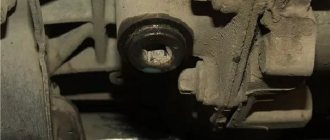Correct oil level Toyota, Renault, Opel, Audi, Ford: values
Below you will find the correct oil level for such car brands as Toyota, Renault, Opel, Audi, Ford. The oil level is indicated in liters:
- Toyota (Toyota) with automatic transmission - 3.5-4.2 l ; Toyota with manual transmission - 2.2-2.8 l .
- Renault (Renault) with manual transmission - 3.1-3.8 l ; Renault with automatic transmission - 2.5-3 liters.
- Opel (Opel) with automatic transmission - 3.8-4.3 l ; Opel with manual transmission - 1.8-2.2 l .
- Audi (Audi) with automatic transmission - 5-8 l ; Audi with manual transmission - 2.7-3.5 l .
- Ford (Ford) with automatic transmission - 5.8-6.7 l ; Ford with manual transmission - 2.9-3.4 liters .
In these car models, the oil level should be exactly like this. If you have a different brand of car, look for the required indicators below.
Correct oil level for Mercedes, BMW, Volkswagen, Peugeot, Honda: values
Oil level in the automatic and manual transmission (gearbox) of a Volkswagen car.
Don’t forget to pay attention to the values of the type of your gearbox. They are indicated next to the make of the car. Here is the correct oil level for Mercedes, BMW, Volkswagen, Peugeot, Honda:
- Mercedes-Benz (Mercedes) with automatic transmission - 3.9-6 l ; Mercedes-Benz with manual transmission - 2.1-3.1 l .
- BMW (BMW) with automatic transmission - 4.3-7.4 l ; BMW with manual transmission - 2.1-3.9 l .
- Volkswagen (Volkswagen) with automatic transmission - 3.9-4.5 l ; Volkswagen with manual transmission - 1.9-4.3 l .
- Peugeout (Peugeot) with automatic transmission - 3.2-3.9 l ; Peugeout with manual transmission - 1.6-2.1 l .
- Honda (Honda) with automatic transmission - 3.9-4.7 l ; Honda with manual transmission - 1.8-2.3 l .
Focus on these values when pouring oil into the gearbox.
Possible damage due to untimely replacement
The transmission performs 2 main functions: reduces friction of parts and protects them from overheating. If you do not check the oil level in the Lada Grants gearbox in a timely manner and do not replace it, the system may malfunction. Over time, the density of the liquid changes, and it protects metal surfaces less well. Gradually, metal particles accumulate in the oil and the friction of parts increases. This leads to their rapid wear and failure of the box. For the same reason, the working components of the gearbox overheat, which negatively affects their performance.
Correct oil level values for Nissan, Subaru, Hyundai, Rav 4, Corolla, Lexus, Cruze
If you did not find your car brand above to see the correct oil level, then look at the list below. Nissan, Subaru, Hyundai, Rav 4, Corolla, Lexus, Cruz - the oil level values should be as follows:
- Nissan (Nissan) with automatic transmission - 2.8-4.2 l ; Nissan with manual transmission - 1.5-2.2 l .
- Subaru (Subaru) with automatic transmission - 2.6-4.2 l ; Subaru with manual transmission - 1.8-2.2 l .
- Hyundai with automatic transmission - 4.5-5 l ; Hyundai with manual transmission - 1.9-2.3 l .
- Lexus (Lexus) with automatic transmission - 3.8-5 l ; Lexus with manual transmission - 1.7-2.8 l .
- Rav 4 with automatic transmission - 3.8-4.9 l ; Rav 4 with manual transmission - 1.8-2.1 l .
- Corolla with automatic transmission - 4.5-5 l ; Corolla with manual transmission - 1.9-2.2 l .
- Cruze with automatic transmission - 4.3-4.9 l ; Cruze with manual transmission - 1.9-2.2 liters .
All values are listed. Now you can check the oil level in your car.
Reference
In a manual gearbox, transmission fluid of a certain quality group. For manual transmission it is AP/GL-4 with a viscosity of SAE 75W-85. The required volume of technical fluid for mechanics is 2.3-3.1 liters. Manufacturing plants recommend replacing the used product. It is recommended not to mix products of different brands. Approximate replacement time after 90 thousand kilometers or after three years of vehicle operation. Checking the oil level in the gearbox is carried out after 15 thousand kilometers of the car.
The inspection and replacement period may be reduced if the vehicle was operated in difficult road and climatic conditions.
Oil level sensor in automatic and manual transmission: where is it located, how to check?
Oil level in automatic and manual transmission
First, let's deal with the manual transmission. In a manual transmission, the oil level sensor will be the drain plug. It is located in the lower part of the transmission housing, but the location may vary for all cars. Before checking the oil level, you must perform the following steps:
- Warm up the transmission and drive the car for 5 to 10 km .
- Then you need to place the car on a flat surface and wait a little while the oil material drains into a special “tray”.
- The car should be tilted slightly to the right; to do this, you can bring weights inside the cabin.
- Then you can begin to unscrew the special neck for a control measurement.
- For a more accurate measurement, you can use a metal rod.
If the oil material does not meet the standard and does not flow out, then it needs to be added. Using a special funnel, slowly pour the oil liquid through the filler plug.
The oil level sensor in the automatic transmission is an oil dipstick. Automatic transmission is most sensitive to oil level. If there is not enough oil material, it may become faulty. How to check? Follow these steps:
- We also warm up the gearbox by driving 5-10 km .
- Park the car on a level surface.
- to the “ P-Parking” and do not turn off the engine.
- Wipe off any dirt around the dipstick to ensure nothing gets into the hole.
- Pull out the sensor and wipe it with a cloth.
- Insert it back and after 3-6 seconds pull it out again.
- If there is enough oil, then it will be a mark near the inscription “HOT” if you measured on a hot one or near o if the measurements were taken on a cold one.
Remember: The oil should have a transparent consistency and a reddish tint, as well as a characteristic odor. If there are deviations in these or other organoleptic indicators, then the oil should be replaced.
Checking transmission oil without a dipstick.
It is necessary to place the vehicle on an overpass with a slight slope and dismantle the protection. This will allow you to top up the transmission lubricant to about. You need to unscrew the filler plug and insert your finger into the hole. You can touch the lubricant. If necessary, add product using a special syringe. A long pipe can be used as a device. What to do if the oil level in the box is low? You need to add liquid, as we already said. Lack of oil in the manual transmission can lead to its premature failure. It is important to promptly inspect the lubricant level. If the first signs of a leak appear, first of all, seals, gaskets, and the reliability of fastening the crankcase and pan are checked. If necessary, worn parts must be replaced with a new set.
Where is the oil level dipstick located in automatic and manual transmissions?
Oil level dipstick in automatic and manual transmissions
The oil dipstick in a car is a device for determining the oil level in the engine crankcase. Where is it located in the manual transmission - answer:
- Most car models with a manual transmission do not have a dipstick. In such cars, there are two holes on the gearbox: for filling and draining oil. The filler plug will be the dipstick in this case.
- You will have to check the oil level using, as car enthusiasts say, your finger.
- Get under the car, unscrew the bolt, stick your finger in, if you feel that there is oil or it is leaking, then everything is normal. If not, then you need to top it up.
In an automatic transmission, you can find out the location of the dipstick like this:
- The fact is that automatic transmission models are developed by different manufacturers, therefore, the dipstick will be located depending on what model the gearbox has.
- Typically, this part is located on the right or left side of the engine.
- The probe is very easy to notice; it is always painted in bright colors: red, yellow, green.
As mentioned above about manual transmission, it happens that there is no dipstick. What should I do and why exactly does it happen that there is no dipstick in the automatic transmission? Here is the answer:
- This means that the driver has a maintenance-free automatic transmission.
- It’s just that the manufacturer took care of the driver’s time and effort by first filling the oil and setting up the electronics.
- In this case, you must first warm up the car until the fluid temperature reaches 40 degrees .
- Then you need to unscrew the filler cap and see whether liquid flows out or not.
- Don't be afraid that all the oil will leak out. This system has a special hose through which the liquid is poured, and it prevents the oil from draining quickly.
Important: If the liquid does not flow out, it means there is not enough liquid. In this case, add until the first drops appear. That's it - now you can tighten the plug. If fluid leaks out, leave it as is.
Optimal oil volume for a manual gearbox
The required volume of oil in a manual transmission is a purely individual concept for each vehicle. Machines of different models differ significantly from each other not only in appearance, but also in design features. Transmission components are no exception, in particular the gearbox, which is responsible for driving the vehicle and changing gears. Accordingly, the amount of lubricant in a manual transmission is individual for each car, and you can see it in the user manual for the vehicle, where the manufacturer indicates the exact displacement of the transmission unit, the type of recommended oil, as well as its optimal level in the system.
Why is it so important that the oil level in a manual transmission exactly meets the standards specified by the car manufacturer? The fact is that the transmission fluid performs tasks that are important for the correct functioning of the gearbox: it removes heat from working surfaces, facilitates the operation of contacting parts, and removes slag components that are formed during friction. If the oil in a manual transmission is less than normal, it ceases to cope with its functional duties. A low oil level first results in a deterioration in the vehicle’s handling, a decrease in its safety on the road, and subsequently, without taking corrective action, it threatens the car owner with gearbox failure and costly repairs.
The following symptoms may indicate that the manual transmission is low on oil:
- transmission slipping when changing gears;
- the lever is very difficult to fix in a certain position; any of the gears, or several at once, may not engage the first time;
- When you try to change gear, the car starts to vibrate or even stall.
Among the signs of low oil level, attentive drivers also note uncharacteristic noises and vibrations from the transmission, a decrease in the speed of the car’s response to gear changes. Excess oil, as well as low oil level, is no less dangerous for the gearbox. If you fill the box with oil in excess of the permissible volume, the liquid will begin to squeeze out the sealing elements during intensive work and flow out. As a result of the leak, the system will return to the problem of low lubrication levels, which is fraught with the consequences described above. Underfilling, as well as overfilling, ultimately leads to disastrous consequences in the form of mandatory manual transmission repairs.
You can prevent malfunctions from the manual transmission by carefully listening to your vehicle and reacting to the slightest deviations from the norm in the operation of functioning components, performing service work in accordance with the manufacturer’s regulations. At the same time, it is important to diagnose the oil level in the manual transmission at least every five thousand kilometers; if the level of transmission emulsion deviates from the norm, immediately top up the lubricant or drain excess fluid if there is excess.
How to set the oil level in automatic and manual transmission?
Oil level in automatic and manual
transmissions Although an automatic transmission is more convenient than a manual transmission, it is technically more inconvenient and its maintenance is much more expensive. To maintain this system in good condition for a long time, you must be able to regulate the amount of liquid poured and contained in it.
How to set the oil level in an automatic transmission:
- In an automatic transmission, the level is checked, first of all, when the engine is warm, so you need to let the car run a little.
- The transport must be on a level surface. Lift the hood lid and move the box to “P-Parking” .
- Remove the oil dipstick.
It is important to know: If you did not turn off the engine, then the oil fluid on the dipstick should be within about. If the oil level is within o, then you should have taken measurements with the engine turned off - cold. Other indicators will be a deviation.
The metal “sensor” has two notches indicating the max and min levels. Pull out the dipstick, wipe it with a napkin and insert it again for 10 seconds , this way you can easily check the oil level in the machine. The oil level should always be in the middle between these notches.
How to set the oil level in a manual transmission:
- With a manual transmission, you need to turn off the engine so that the oil does not circulate and cools down. It is very important.
- Determine the type of wrench to unscrew the cap.
- There is no special meter, so you can take a metal rod, dip it in the oil liquid and check what level it is at or check with your finger.
- If the liquid flows out, then everything is in order - the level is set. There is enough oil, and it is better to close the lid so as not to spill.
With a manual transmission, there are no special instructions on how to set the oil level. The main thing is to just check its level in a timely manner.
Using the probe
The dipstick helps check the oil level in the gearbox. Where is the dipstick located?
A dipstick is a tool that is equipped with a number of cars, which is necessary to check the amount of fuel in the speed box. As a rule, it has a bright color. It should be noted that not all cars are equipped with a dipstick.
When the dipstick is pulled out, it is necessary to wipe it dry with a rag, after which it is installed back. There are special notches with symbols on the probe. Using them you can accurately determine whether the amount of oil added is sufficient or not. On an automatic transmission, the optimal indicator is the presence of oil between the minimum and maximum marks.
By periodically checking the oil in the box, the driver can thereby notice an oil leak in time. This may cause the gearbox to fail prematurely. The oil must be replaced if its consistency begins to resemble water or, on the contrary, becomes too thick.
You should not start checking immediately after stopping the car; you must wait 20-30 minutes. This time is enough for the existing oil in the box to cool to the optimal temperature.
On a number of car versions, instead of a dipstick, there is a “control plug” through which oil can be poured. The oil level check plug is found on BMW and Opel cars. This item is located behind the SDC. Timely replacement of transmission oil will ensure uninterrupted operation of the automotive system.
Normal oil level in automatic and manual transmission: video, photo
Normal oil level in an automatic transmission and manual transmission
As mentioned above, if you measured the oil level in an automatic transmission when it was cold, then it should be within the “ COLD” or “ COLL” inscription - this is normal. If it’s hot, then within the “ HOT” . See above in the picture and below in the photo:
Normal oil level in the machine
Other values are additional information. What it means should be looked at in the manufacturer's instructions. The norm in a manual transmission is that oil should flow out of a special hole, as in the photo below.
Normal oil level in manual transmission
Watch the video clips below for more details.
Average car oil change frequency
The interval between oil changes depends on a number of factors described above. On average, it is 10-15 thousand kilometers with a mixed “city-highway” cycle. If the driver moves only in a metropolitan area, when the engine operates in a gentle mode, the interval increases to 20 thousand km.
With constant increased loads on the power unit, replacement will be needed after 5,000 km. In practice, each driver determines the timing of replacement himself, depending on the operating mode of his “iron horse,” the state of the power plant and other factors.
The oil level in automatic transmission and manual transmission is above normal: consequences
Oil level in automatic transmission
Replacing transmission fluid in automatic and manual transmissions can occur for various reasons. Most often, it is changed when the permissible mileage limit from the previous replacement is worked out or when purchasing a used car if the previous owner did not properly monitor the condition of the car.
Important: If lubricant overflow occurs, it must be eliminated as quickly as possible. This will protect your car from possible serious damage to the mechanism.
Consequences of exceeding the oil level in the automatic transmission:
- The oil whips up while the machine is running, forming foam.
- Heating the elements causes the liquid to expand even more.
There is no point in waiting for the excess to squeeze out on its own through the dipstick and breather, as all this can lead to the following consequences:
- Malfunction of the gearbox.
- Loss of some speeds and modes.
- Significant overheating of the components occurs.
- Breakage of friction discs.
On mechanics, the influence of overflow is not so great, but it also leads to some unpleasant moments. Consequences in manual transmission:
- The pressure throughout the system increases.
- Intense foaming occurs.
- There is a high probability of damage to rubber seals and seals.
If an increased level of transmission oil is detected, it is better to use a simple method to remove the excess. To do this you will need a large medical syringe and a dropper. The syringe is connected to one end of the dropper, and the other end is lowered into the neck of the dipstick. By lifting the piston, the required amount of liquid is pumped out.
Lack of motor oil: how to determine what the catch is?
Knowing how to check the oil level in an automatic transmission, car owners can easily add consumable fluid to the required level. It is not difficult to determine that it is high time to fill the oil in an automatic transmission above the current level. If the oil level in the automatic transmission is insufficient, the car itself will indicate to the owner the lack of oil by:
increase in noise. There should be no extraneous noise when starting the car. If the brake pedal is depressed, the car is stationary, and strange noises appear from under the hood, this may be due to a low transmission oil level;
loss of smoothness. When the car jerks when changing to a higher gear, this is one of the first signs of insufficient oil level.
Sometimes both signs appear simultaneously, which indicates 100% problems with consumable liquids. Failure to maintain optimal automatic transmission oil levels can lead to serious transmission problems.
How to correctly measure the oil level in automatic transmissions and manual transmissions hot and cold: methods
Oil level in automatic transmission
As mentioned above, in order to check the oil level in a car with automatic transmission, you must first warm up the engine. It will be enough to drive 30-40 km . In a car with an automatic transmission, the oil is checked either “hot”, and the engine and gearbox must be warm, or “cold” - in a calm state.
Here's a way to check the oil level in an automatic transmission " while it's hot " :
- Find a flat surface and place the car on it.
- The plane on which you place the machine must be level so that the liquid does not drain to the lower level.
- The car must be in park (on the gearbox), and the engine must be in working condition.
- The engine should idle for 5 minutes.
- Now remove the dipstick, clean it with a dry, clean cloth and put it back in place.
- Remove the “sensor” again and look at the oil level mark.
- If the level is not lower than the min near the “HOT” , then there is no need to top up.
It is worth noting: Most automatic transmissions are equipped with four marks for the oil level: 2 - min and max for hot oil and 2 of the same for cold oil. When the engine is warm, the oil fluid should be at the upper level for “hot”. If the engine is cold, then the level should be between the lower o for “cold”.
Important: Also, the oil level can change spontaneously due to the presence of many cavities (it drains into them). Therefore, measurements should be taken over several days - daily.
to check the oil level in the manual transmission only with the ignition off:
- It is best to do this after the machine has been idle for some time.
- If the car has just been turned off, you should let it sit for at least 10 minutes .
- During this time, the oil will drain into the oil pan.
- Be sure to place the car on a flat horizontal surface and release the handbrake.
- Next, you should take out the oil dipstick and clean it of dirt and oil residues. Place it in its original place, wait 20-30 seconds and remove it again.
- The dipstick will show the exact oil level.
If your mechanics do not have a dipstick, then check with a metal rod or your finger. Unscrew the bolt and insert a rod no longer than 7-8 cm . Take it out, if it is stained with oil, then everything is in order.
Checking the level and changing the oil in the Lada Granta gearbox
According to the instructions of the VAZ car manufacturer, it is recommended to change the transmission oil in a Lada Granta car every 75,000 km or after 5 years of operation. This process is simple and even a novice car enthusiast can handle it. From this article you will learn not only how to check the oil level in the Lada Granta gearbox, but also how to replace it yourself.
In order to check the oil level in the gearbox, you need to carry out a number of simple operations:
- Turn off the engine (check with the engine off).
- Remove the filter housing.
- Remove the fluid level indicator from the hole in the gearbox.
Gearbox for Lada Granta - Wipe the pointer and put it back again until it stops.
- Remove the pointer.
Checking the oil level with a dipstick - We look carefully, if the fluid level in the gearbox is between MIN and MAX, then everything is in order, if it is lower, then it needs to be topped up to the norm.
How to replace?
Many people prefer to change transmission fluid at service stations. On the one hand, this is the right decision since the work will be performed by a qualified specialist, but on the other hand, you will have to pay him your hard-earned money. But if you want to save money or are reluctant to part with money, then you can do it on your own; the replacement process after reading our article should not cause you any difficulties.
If you have an automatic transmission
Automatic transmission Lada Granta
Replacing fluid in an automatic transmission is a little more complicated than in a manual transmission, but it will not cause any particular difficulties even for a beginner.
Which oil should you choose?
Let's say right away that the oil used in the Lada Granta automatic transmission does not need frequent replacements, because its excellent performance properties guarantee the operation of the gearbox throughout the entire service life of the car. This means that on a Lada car with an automatic transmission, fluid replacement is necessary only when repairing the gearbox itself. Reuse of transmission fluid is strictly prohibited! Today there is simply a huge assortment of different high-quality oils on sale that are suitable for Lada Granta automatic transmissions, but the pros recommend Genuine EJ-1 ATF (from JX Nippon Oil and Energy Corporation).
Be sure to remember! All parts of the machine box need to be wiped only with lint-free paper. Even the smallest foreign particles that get inside the box can cause irreparable harm to it, namely, there is a risk of clogging the throttle holes, which in turn will lead to disruption of the entire automatic transmission until it completely fails.
What tools will you need?
- key to "ten";
- ring key to “nineteen”;
- hexagon to “five”;
- new automatic transmission oil;
- paper, only lint-free;
- empty container.
Replacement steps
It is best to carry out fluid replacement work on a special lift, but if not, then a garage will do:
- We unscrew the drain plug (in the picture it is number 2) with the key set to “19”.
- Then the overflow (number 3 in the picture) using a hexagon at “5”.
Automatic transmission of the Lada Granta car: 1 - pallet; 2 - drain plug; 3 - overflow plug. - Drain the liquid into a previously prepared empty container.
- We put the overflow plug in its original place, and then screw the drain plug, after installing a (preferably new) O-ring on it.
- Let us remind you that the required volume of transmission oil for the Lada Granta automatic transmission is approximately 1 liter. We take out the dipstick and pour approximately 1 liter of new automatic transmission oil into the hole.
- We measure the fluid level, it should be between “MIN” and “MAX” on the indicator, if it is less, then add fluid.
If you have a manual transmission
Which oil is preferable?
Manual transmission of a Lada Granta car
From domestic oils in the Lada Granta manual transmission, you can use Lukoil TM 4. It is important to know that the viscosity class depends on the region in which the car is operated - 75W-(80, 85, 90), 80W-(85 , 90).
What is necessary
To replace manual transmission fluid you will need:
- key to "seventeen";
- manual transmission oil;
- funnel;
- hose;
- capacity, approximately 4 liters;
- rags.
Replacement steps
- The car must be driven into the inspection pit, and before that it is advisable to thoroughly warm up the transmission system.
- First, you need to thoroughly clean the surface around the transmission drain hole. The Lada Granta gearbox requires approximately 3.1-3.5 liters of fluid; therefore, the container placed under the drain hole should be at least four liters, and maybe a little more.
- Using the key set to “17”, unscrew the drain plug.
The transmission oil level should be between “MIN” and “MAX”. Drain hole location - Drain the old oil into a container and screw in the plug.
- Pour fresh fluid into the box through the hose that must be inserted into the dipstick hole.
Filling ZIC fluid into the gearbox
As you can see, there is nothing complicated and these operations will not take much time, and replacing the transmission fluid yourself will not only save money, but will also save you from waiting in a long line for a car service center.
Video “Changing the oil in the gearbox on a Lada Granta”
After watching this video, you will be able to not only measure and change the oil in the Lada Granta gearbox yourself.
In this article, we tried to describe in detail the process of measuring and replacing transmission fluid in the manual and automatic transmissions of the Lada Granta. If the information provided was useful to you, please leave your feedback.
AvtoZam.com
CVT oil level: check steps
Oil level dipstick in the variator
You can check the oil level in the variator yourself, but it still requires some knowledge and the correct sequence of actions. Here are the verification steps:
- The machine should be on a level surface and preferably in a dry place.
- Initially, the engine warms up well. Liquid temperature indicators are 35-45 degrees Celsius .
- Next, you should run the CVT transmission in all modes.
- After this, you need to let the engine cool. How long this will take depends on the car model. For some cars, fluid measurements can be made one to two minutes after turning off the engine. For others - in half an hour. On some brands, the process of measuring the oil level is also performed on a hot engine.
Next stage:
- Open the hood and look for the dipstick underneath. As a rule, it is near the top of the motor. The color of its handle is bright yellow.
- The dipstick is removed and thoroughly wiped dry, after which it is inserted back and the oil level is determined.
- If everything is normal, the oil mark will be between the extreme indicators ( min and max ) on it.
“Cold” and “Hot” are also marked on the dipstick . If the engine is warm, the measuring tool is examined from the hot ; if it has cooled down, then from the cold . There may be another abbreviation: “add - 1pt”, “don’t - full - max” .
Important to note: This process may vary for different models. Therefore, it is worth familiarizing yourself with the procedure specifically for a specific car.
Now you know how to measure the oil level in the gearbox, and you know where the dipstick and other parts are located. Keep an eye on the condition of your car so that it will serve you well and for a long time. Good luck!
Let's start checking
Where is the oil level dipstick located? This element is usually located in the exhaust manifold area. A typical engine oil level dipstick is yellow or red. It looks like the one shown in the photo below.
It can also be painted black. But in any case, its configuration and shape will remain unchanged. You can easily determine its location in the engine. After the engine has cooled down, we begin checking. We take the element out by the handle and wipe it with a dry cloth. Next, install it back into the hole. After a couple of seconds, the dipstick can be removed again to check the engine oil level. Now let's look at his testimony carefully.
On almost all cars it has two marks - MIN and MAX. There are also intermediate divisions. What is considered a normal level? The readings should be between these two marks (maximum and minimum) or slightly above average. If the lubricant is at the MIN mark, the engine will experience oil starvation. In this case, the level must be urgently restored. You only need to add oil of the same brand and viscosity that was previously used during replacement. After this, check the level again. If it returns to normal, install the oil level dipstick back until it clicks and tighten the filler neck.
As you can see, everything is quite simple. This operation does not take much effort. With timely checks, you can prevent oil starvation of the engine, thereby extending its life.











